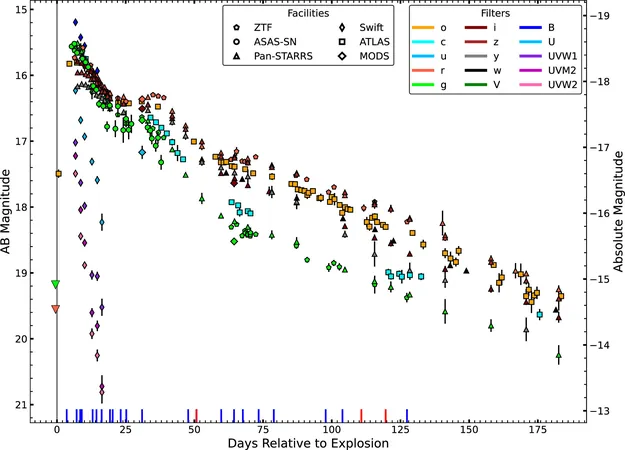
Astronomers Uncover Rare Supernova, Offering Insight into the Early Universe
2024-11-25
Author: Emma
Introduction
In a groundbreaking discovery, an international team of astronomers has detected an incredibly rare supernova, designated 2023ufx, which marks the most metal-poor stellar explosion ever documented. This phenomenon originated from a red supergiant star that underwent core collapse, resulting in the explosion on the periphery of a dwarf galaxy situated near our Milky Way.
Significance of Metallicity
The team’s investigation revealed that both the supernova and the surrounding galaxy possess low metallicity, indicating a scarcity of elements heavier than hydrogen and helium. This finding is crucial, as the composition of metals within supernovae plays a pivotal role in their characteristics, such as the evolution and demise of stars. Lead author Michael Tucker of The Ohio State University emphasizes that understanding these early explosive events can provide astronomers a glimpse into the universe’s formative years when metals were virtually non-existent.
Influence on Galactic Evolution
"As we seek to unravel the origins of the Milky Way, it's essential to understand how the earliest supernovae influenced subsequent generations of stars," Tucker explained. This research not only enhances knowledge surrounding the life cycle of stars but also holds great significance for modeling how galaxies evolve over time.
Role of Dwarf Galaxies
Dwarf galaxies serve as valuable analogs for the conditions astronomers believe existed in the primordial universe. This research sheds light on the fact that even though the initial galaxies were metal-poor, significant time allowed larger, brighter galaxies, like those near the Milky Way, to accumulate metal content from stellar explosions.
Factors Associated with Supernovae
The quantity of metals in a supernova is associated with several factors, including the duration of its brightness and the frequency of nuclear reactions during the event. Tucker pointed out that low-mass stars can also be at risk of collapsing into black holes due to their metal content.
Publication and Discovery
Published in The Astrophysical Journal, this study marks only the second documented instance of a low-metallicity supernova, but the unique circumstances of 2023ufx’s location make it particularly intriguing. Generally, metal-poor supernovae are too faint to be observed from our galaxy. However, thanks to advanced telescopic technology like NASA's James Webb Space Telescope, astronomers can now spot distant metal-poor galaxies with far more ease than ever before.
Unexpected Brightness Pattern
Interestingly, the discovery of supernova 2023ufx was somewhat serendipitous. Observations indicated that its brightness remained consistent for approximately 20 days before dimming, in stark contrast to its metal-rich counterparts, which typically shine for around 100 days. Notably, a substantial volume of fast-moving material was ejected during the explosion, suggesting that the star was spinning at a remarkable rate.
Implications of Rapid Spin
This phenomenon indicates that rapidly spinning metal-poor stars may have been more prevalent in the universe’s early epochs than previously thought. Tucker posits that the supernova’s behavior could be attributed to weak stellar winds—streams of particles escaping from the star—which contributed to the immense energy released.
Future Studies
Overall, the insights gained from this discovery offer a foundational understanding for astronomers to further investigate metal-poor stars in different cosmic scenarios, potentially enriching theoretical models on supernova behavior in the universe’s infancy. Future studies are expected to explore whether supernova 2023ufx was once significantly larger or if it lost mass to an undiscovered binary companion.
Conclusion
As we await more data, the implications of this discovery could revolutionize our understanding of cosmic evolution—revealing the secrets of the universe and its very first stars, one supernova at a time. Stay tuned for more exciting updates in the world of astronomy!









 Brasil (PT)
Brasil (PT)
 Canada (EN)
Canada (EN)
 Chile (ES)
Chile (ES)
 España (ES)
España (ES)
 France (FR)
France (FR)
 Hong Kong (EN)
Hong Kong (EN)
 Italia (IT)
Italia (IT)
 日本 (JA)
日本 (JA)
 Magyarország (HU)
Magyarország (HU)
 Norge (NO)
Norge (NO)
 Polska (PL)
Polska (PL)
 Schweiz (DE)
Schweiz (DE)
 Singapore (EN)
Singapore (EN)
 Sverige (SV)
Sverige (SV)
 Suomi (FI)
Suomi (FI)
 Türkiye (TR)
Türkiye (TR)